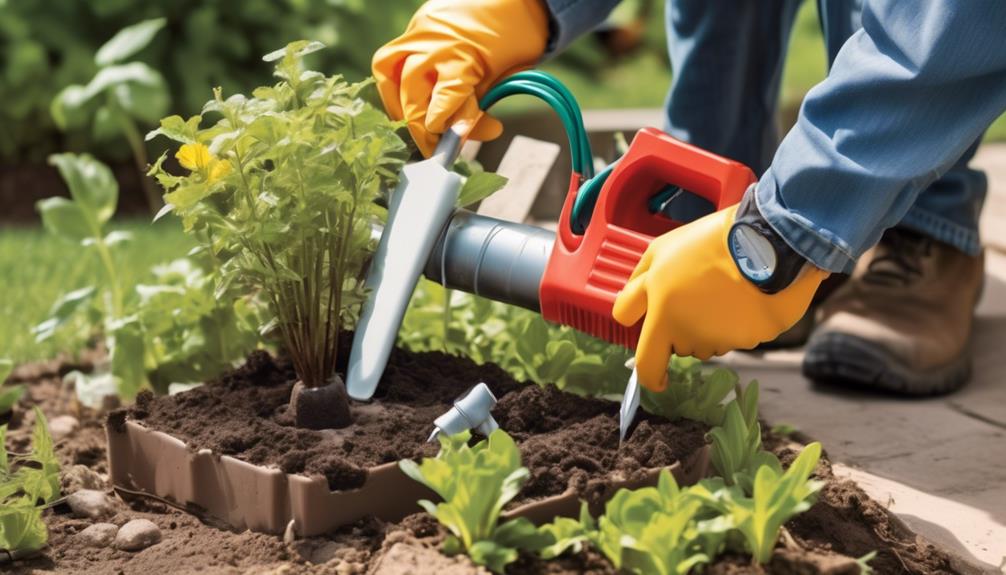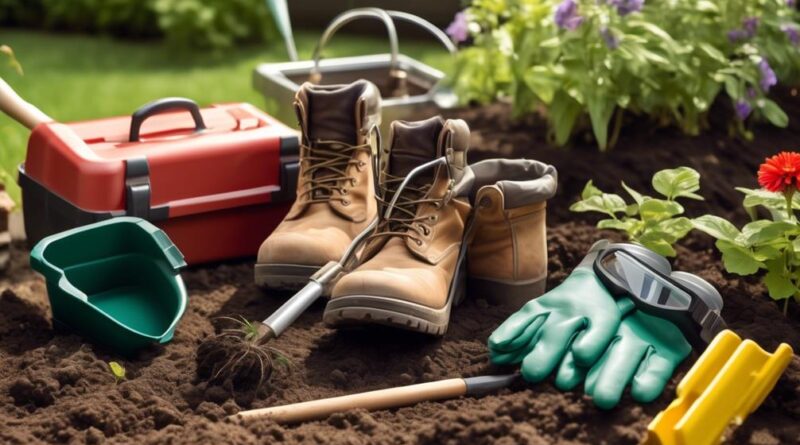Why Is Safety Essential in Outdoor Gardening?
This post may contain affiliate links which means I may receive a commission for purchases made through links. As an Amazon Associate, I earn from qualifying purchases. Learn more on my Private Policy page.
Do you ever stop to consider the potential risks involved in your outdoor gardening activities? From the sharp edges of pruning shears to the harmful effects of chemical fertilizers, there are numerous hazards that can pose a threat to your safety.
Prioritizing safety in outdoor gardening isn't just about avoiding accidents; it's about ensuring that you can continue enjoying your garden without unnecessary risks.
So, what specific steps can you take to safeguard yourself while tending to your garden?
Importance of Gardening Safety
Ensuring your safety while gardening is essential for preventing injuries and enjoying the benefits of outdoor activities.
Wearing proper attire is a key aspect of gardening safety. Before you start working in the garden, make sure to wear appropriate clothing such as long pants, sturdy closed-toe shoes, and gloves to protect yourself from cuts, scrapes, and insect bites. Additionally, consider wearing a wide-brimmed hat and applying sunscreen to shield yourself from the sun's harmful rays.
Injury prevention is another crucial element of gardening safety. When lifting heavy objects such as bags of soil or potted plants, remember to bend your knees and lift with your legs to avoid straining your back. Using ergonomic gardening tools with padded handles can also help reduce the risk of repetitive strain injuries.
It's important to take regular breaks and stay hydrated, especially on hot days, to prevent exhaustion and dehydration.
Choosing the Right Tools
When selecting tools for your gardening tasks, prioritize those with ergonomic designs to minimize strain on your hands and wrists. Ergonomic tools are designed to fit the natural contours of your hand, reducing the effort required to use them. Look for tools with cushioned grips and handles that are the right size for your hand to prevent discomfort and potential injury. Additionally, consider tools with adjustable handles or lengths to suit your height and reach, further reducing the risk of strain.
In addition to choosing ergonomic tools, it's crucial to maintain them properly. Regular tool maintenance not only prolongs their lifespan but also ensures that they function safely and effectively. Keep cutting tools sharp to make clean cuts, reducing the effort needed and minimizing the risk of accidents. Clean and oil metal parts to prevent rust, and tighten any loose screws or hinges to maintain stability and prevent unexpected breakage during use.
When it comes to hand tools, such as trowels and pruners, select ones with a comfortable grip and lightweight design. This will reduce the strain on your wrists and forearms during prolonged use. Long-handled tools should have adjustable lengths to match your height and prevent unnecessary bending or overreaching, which can lead to muscle strain and discomfort.
Proper Lifting Techniques
To prevent strain and potential injury, it's essential to use proper lifting techniques when handling heavy gardening materials and equipment. Preventing back injuries is crucial in outdoor gardening, and following lifting guidelines can significantly reduce the risk of harm.
When lifting heavy objects such as bags of soil or large potted plants, always remember to bend your knees and use your leg muscles to bear the weight. Keep the object close to your body as you lift, and avoid twisting your back while carrying it. This technique helps distribute the weight evenly and minimizes the strain on your back muscles.
Another important aspect of proper lifting is to avoid lifting heavy items above shoulder level, as this can put excessive strain on your upper back and shoulders. If you need to lift something to a higher level, consider using a step stool or ladder to minimize the strain on your back.
Additionally, be mindful of your own physical limitations and don't attempt to lift objects that are too heavy for you to handle safely. When in doubt, ask for assistance or use mechanical aids such as wheelbarrows or hand trucks to transport heavy materials.
Sun Protection
Protect your skin from the sun's harmful rays by wearing sunscreen, a wide-brimmed hat, and sunglasses when working in the garden. Sun protection is crucial to prevent sunburn, premature aging, and skin cancer.
Here are some essential tips for sun protection while gardening:
- Apply sunscreen: Use a broad-spectrum sunscreen with an SPF of 30 or higher. Apply it generously to all exposed skin, including your face, neck, ears, and hands. Reapply every two hours, or more often if you're sweating or engaging in water-related activities.
- Wear protective clothing: Choose lightweight, long-sleeved shirts and pants to shield your skin from the sun. Look for clothing with a tight weave or specially designed with built-in UPF (Ultraviolet Protection Factor) for added sun protection.
- Use a wide-brimmed hat: Opt for a hat with a brim that extends at least three inches all around to protect your face, ears, and the back of your neck from direct sunlight.
- Wear sunglasses: Select sunglasses that offer 100% UV protection to shield your eyes from harmful UV rays. Look for wraparound styles to provide additional coverage and protection for the delicate skin around your eyes.
Understanding Chemical Safety
As you safeguard your skin from the sun's harmful rays, it's important to be mindful of understanding chemical safety when using gardening products. Chemical exposure risks are prevalent when handling fertilizers, pesticides, and other gardening chemicals. To mitigate these risks, always wear appropriate protective measures such as gloves, long-sleeved shirts, pants, and closed-toe shoes when working with these substances. Additionally, using a mask to avoid inhaling chemical fumes is crucial.
Understanding hazardous substance labeling is essential for your safety. Always read and follow the instructions and warnings on the product labels. Labels provide important information about the potential risks associated with the product, its proper usage, and first aid measures in case of accidental exposure.
Safe disposal of chemical products is equally important. Improper disposal can lead to environmental contamination and pose a threat to human and animal health. Always dispose of chemical containers according to local regulations. Many communities have specific guidelines for the disposal of hazardous substances. This often involves taking them to designated collection sites or participating in hazardous waste collection events.
Preventing Trips and Falls
Ensure your gardening area is free from clutter and obstacles to prevent trips and falls. Pathway maintenance is crucial for ensuring a safe gardening environment. Regularly inspect and clear pathways of any debris, such as fallen branches, rocks, or tools, that could pose a tripping hazard. Hazard identification is key in preventing accidents, so be sure to keep an eye out for uneven surfaces, slippery areas, or exposed roots that may cause you to stumble.
Wearing proper footwear is essential for outdoor gardening. Choose shoes with good traction to prevent slipping, and ensure they fit well to provide stability. Additionally, practicing balance techniques can help minimize the risk of falls. When bending or reaching for objects, maintain a wide stance and a low center of gravity to improve stability and reduce the likelihood of losing your balance.
Here's a recap to help you prevent trips and falls in your gardening area:
- Regularly clear pathways of debris to prevent tripping hazards.
- Conduct thorough hazard identification to spot potential risks and address them promptly.
- Wear appropriate footwear with good traction and ensure a secure fit.
- Practice balance techniques such as maintaining a wide stance and low center of gravity when gardening.
Handling Outdoor Electrical Safety

Inspect your outdoor electrical equipment regularly to ensure it's free from hazards and properly maintained, building on the importance of conducting thorough hazard identification for a safe gardening environment.
Electrical hazards can pose serious risks in outdoor gardening, but with proper precautions, you can minimize the potential dangers. When working with outdoor wiring, safety measures are critical. Start by checking all electrical cords and equipment for any signs of damage such as fraying, cuts, or exposed wires.
Make sure all electrical outlets are equipped with Ground Fault Circuit Interrupters (GFCIs) to prevent electric shock in wet conditions. It's also essential to keep all electrical connections and outlets dry and covered to avoid water damage and short circuits.
Moreover, when using electrical tools or appliances, always ensure they're specifically designed for outdoor use and are equipped with waterproof covers. Never use indoor extension cords or electrical equipment outdoors as they aren't built to withstand outdoor conditions.
Additionally, use insulated tools when working on or around electrical systems to prevent electric shock. When handling outdoor electrical safety, always remember to unplug any equipment before making adjustments or repairs to prevent accidental shocks.
First Aid Preparedness
In case of injuries during outdoor gardening activities, having a well-stocked first aid kit readily available is crucial for prompt treatment. When it comes to outdoor gardening, accidents can happen unexpectedly, so being prepared with the necessary first aid supplies is essential for ensuring a swift response to any injuries that may occur.
Importance of First Aid Preparedness
- Emergency Response: With a properly stocked first aid kit, you can quickly attend to minor cuts, scrapes, or insect bites, preventing them from developing into more serious issues.
- Immediate Treatment: Having the necessary supplies on hand allows you to provide immediate care in the event of an injury, reducing the risk of complications and promoting faster healing.
- Safety Assurance: Knowing that you have a well-equipped first aid kit within reach can provide peace of mind, allowing you to focus on your gardening tasks without worrying about potential accidents.
- Preparedness for Emergencies: In the event of a more serious injury, having a first aid kit with essential items can help stabilize the situation until professional medical assistance arrives.
Frequently Asked Questions
What Are Some Common Outdoor Gardening Hazards That People May Not Be Aware Of?
When gardening outdoors, it's important to be aware of common hazards like poisonous plants and sharp tools. Sun exposure and dehydration are often overlooked but can pose serious risks to your health.
Are There Any Specific Safety Precautions for Gardening in Extreme Weather Conditions, Such as High Winds or Heavy Rain?
When gardening in extreme weather, take safety precautions seriously. Wear appropriate safety gear and protective clothing to shield yourself from the elements. Secure loose items and structures to prevent damage during high winds or heavy rain.
How Can I Protect Myself From Potential Wildlife Encounters While Gardening Outdoors?
When gardening outdoors, wildlife safety is important. Wear protective clothing like long sleeves and pants, and use gloves. Be aware of your surroundings and make noise to avoid surprising animals. Keep a safe distance.
Are There Any Safety Tips for Working in Remote or Isolated Outdoor Gardening Locations?
When working in remote or isolated gardening areas, ensure equipment safety and have communication methods in place. Stay aware of your surroundings and potential hazards. Always prioritize your safety and be prepared for any unexpected situations.
What Should I Do if I Encounter an Emergency Situation While Gardening Outdoors and Need to Seek Help?
If you encounter an emergency while gardening outdoors, first aid and emergency response are crucial. Have emergency contacts readily available and communicate the situation clearly. You must be prepared to seek help promptly in case of any emergency.
Conclusion
So, remember to prioritize safety in your outdoor gardening activities.
By choosing the right tools, using proper lifting techniques, and protecting yourself from the sun, you can ensure a safe and enjoyable gardening experience.
Understanding chemical safety, preventing trips and falls, and handling outdoor electrical safety are also important aspects to consider.
Additionally, being prepared with first aid is crucial in case of any accidents or injuries.
By following these safety guidelines, you can take care of yourself and your garden, and enjoy the benefits of outdoor gardening with peace of mind.
